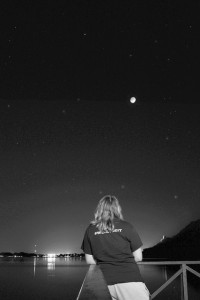
Nathaniel Nelson/Winonan
On Sunday, Sept. 27, the sky was lit by a rare celestial occurrence known as the supermoon eclipse.
Students across campus dashed outside around 10 p.m. to catch a glimpse of the historic event. Amelia Malmberg, president of the WSU astronomy club, watched the eclipse from the comfort of her home.
“I was in the parking lot of my apartment building,” Malmberg said. “There were other club members with me, as well as some astronomy students.”
Malmberg explained this eclipse was the result of a series of celestial events.
“It was a full lunar eclipse, which means that the sun, moon and Earth were all perfectly aligned,” Malmberg said. “The moon appears red due to the Earth going in between the sun and the moon.”
This red-hued moon, often called the blood moon, only appears during a full lunar eclipse due to chemicals in our atmosphere, Malmberg said.
“The effect is similar to that of a sunset in that the more stuff in our atmosphere, the more stuff for sunlight to interact with, and the redder it will appear,” Malmberg said.
It was not the red hue that made this eclipse unique, but rather the size of the moon itself that set this event apart from other eclipses.
“It was also an uncommon eclipse because it was considered a supermoon, which means that the moon is as close as it can be to the Earth,” Malmberg said. “It therefore appears approximately 14 percent larger and typically shines quite a bit brighter as well.”
She also explained that the moon has an elliptical orbit, meaning it is not always the same distance from earth. At its farthest point, the apogee, sits 251,968 miles above the Earth’s surface. Its closest point, known as the Perigee and the point of the Supermoon, is only 225,804 miles away. This change in distance allowed stargazers on the ground to see more detail on the moon than any average night, which only compounds during the eclipse.
While there was not an organized event from the club to watch the eclipse, Malmberg said astronomy club members from all over campus got out to see the moon.
“I know many members that watched from multiple locations throughout Winona,” Malmberg said.
One of these members, Winona State junior Lukas Hoover, met up with a group of five people to watch the eclipse. He explained this eclipse was a special event he would never miss.
“The next one won’t happen for until 2033, and it doesn’t require a telescope,” Hoover said. “It’s history in the making.”




























































